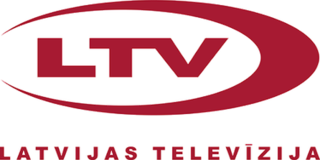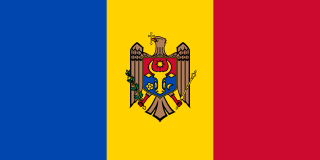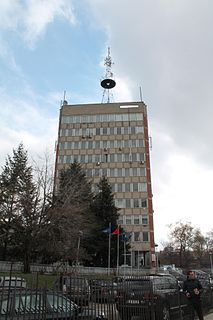The media of Romania refers to mass media outlets based in Romania. Television, magazines, and newspapers are all operated by both state-owned and for-profit corporations which depend on advertising, subscription, and other sales-related revenues. The Constitution of Romania guarantees freedom of speech. As a country in transition, the Romanian media system is under transformation.
The media of Belarus are mass-media outlets based in Belarus. Television, magazines, and newspapers are operated by state-owned and for-profit corporations and depend on advertising, subscriptions, and other sales-related revenue. The Constitution of Belarus guarantees freedom of speech, but this is contradicted in practice by repressive and restrictive laws. Arbitrary detention, arrests, and harassment of journalists are frequent in Belarus. Anti-extremism legislation targets independent journalism, including material considered unfavourable to the president.

Australia has a modern and diverse media industry spanning traditional and digital formats, and catering mostly to its predominantly English-speaking population. In 2018 the Press Freedom Index ranked Australia 19th out of 180 countries

Latvijas Televīzija is the state-owned public service television broadcaster in Latvia.
The media of Georgia refers to mass media outlets based in the Republic of Georgia. Television, magazines, and newspapers are all operated by both state-owned and for-profit corporations which depend on advertising, subscription, and other sales-related revenues. The Constitution of Georgia guarantees freedom of speech. Georgia is the only country in its immediate neighborhood where the press is not deemed unfree. As a country in transition, the Georgian media system is under transformation.
Latvian Independent Television is a major private television company in Latvia, founded in 1996. LNT features TV series, news and entertainment programmes, airing 24 hours a day in Latvian.
The media of Armenia refers to mass media outlets based in Armenia. Television, magazines, and newspapers are all operated by both state-owned and for-profit corporations which depend on advertising, subscription, and other sales-related revenues. As of 2018, there were few indicators of a healthy and independent media.

The media of Croatia refers to mass media outlets based in Croatia. Television, magazines, and newspapers are all operated by both state-owned and for-profit corporations which depend on advertising, subscription, and other sales-related revenues. The Constitution of Croatia guarantees freedom of speech and Croatia ranked 63rd in the 2016 Press Freedom Index report compiled by Reporters Without Borders, falling by 5 places if compared to the 2015 Index.
The media of Cyprus refers to mass media outlets based on the island of Cyprus, including both the Republic of Cyprus (RoC) and the Turkish Republic of Northern Cyprus (TRNC). Television, magazines, and newspapers are all operated by both state-owned and for-profit corporations which depend on advertising, subscription, and other sales-related revenues.
Since 1991 Estonia has changed from being a former Soviet republic to a member of the European Union and the European Monetary Union, making a rapid transformation in several fields, including the media, which is a vibrant and competitive sector. For many years Estonia has been among the top ten in Reporters Without Borders’(RSF) Press Freedom Index. In 2017 it has been ranked 12th out of 180 countries by RSF while Freedom House assigned Estonia’s press freedom a score of 16/100. A cross-media landscape that embraces traditional media as well as the Internet and digital media characterises the contemporary media system in Estonia.
Before the independence from the Soviet Union (USSR) in 1990, Lithuanian print media sector served mainly as a propaganda instrument of the Communist Party of Lithuania (LKP). Alternative and uncontrolled press began to appear in the country starting from 1988, when the Initiative Group of the Reform Movement of Lithuania Sąjūdis was established. After the declaration of independence the government stopped interfering in the media outlets which for the most part were first privatised to their journalists and employees and later to local businessman and companies. Currently media ownership in Lithuania is concentrated among a small number of domestic and foreign companies.

The media of Moldova refers to mass media outlets based in the Republic of Moldova. Television, magazines, and newspapers are all operated by both state-owned and for-profit corporations which depend on advertising, subscription, and other sales-related revenues. The Constitution of Moldova guarantees freedom of speech. As a country in transition, Moldova's media system is under transformation.
The media of Russia refers to mass media outlets based in the Russian Federation. The media of Russia is diverse, with a wide range of broadcast and print outlets available to the consumers. Television, magazines, and newspapers are all operated by both state-owned and for-profit corporations which depend on advertising, subscription, and other sales-related revenues. Even though the Constitution of Russia guarantees freedom of speech the country is plagued by both government and self-censorship. As a country in transition, Russia's media system is under transformation.
In Slovakia, political information is disseminated through the mass media: television, radio, the press, and the internet. The public is becoming increasingly reliant on the internet for news, with television and the press becoming less important as news sources.
The media of Afghanistan includes printing, broadcasting, and digital. It is mainly in Dari and Pashto, the official languages of the nation. According to the Attorney General's Office of Afghanistan, "there are 1,879 active media outlets in Afghanistan which are called as one of the main achievements of the country in the past 18 years."

Ukraine is in 102nd place out of 180 countries listed in the 2017 World Press Freedom Index. Organizations like Reporters Without Borders, Human Rights Watch and Committee to Protect Journalists have condemned Poroshenko government recent bans on media.

The Russian language in Latvia is the second most commonly used language at home and 26.9% of the population were ethnic Russians (2011).

The Media of Kosovo consists of different kinds of communicative media such as radio, television, newspapers, and internet web sites. Most of the media survive from advertising and subscriptions.
TV, magazines, and newspapers are all operated by both state-owned and for-profit corporations which depend on advertising, subscription, and other sales-related revenues.
The Media of the Czech Republic refers to mass communication methods through broadcasting, publishing, and the Internet.






